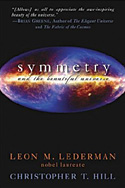Reviewed by David Harris
Symmetry and the Beautiful Universe
Leon M. Lederman and Christopher T. Hill
Prometheus Books, Amherst,
New York, 2005
 |
Perhaps the key lesson we learned from Einstein is the significance of physical symmetries in the laws of nature. For example, the special theory of relativity is, in a nutshell, nothing more than a description of the symmetries of space-time. In modern particle physics, symmetries have such a fundamental role that particular theories are often referred to by the names of the symmetry structures lying at their cores, such as the seemingly obscure SU(5) and SO(10)symmetries.
Amid the cutting edge symmetries of current, narrow fields of research, it is easy to forget that much of physics can be understood in terms of symmetries, and even elementary physics gains new interpretations when cast in the light of symmetries. The purpose of Lederman and Hill's book is not to push the readers of popular science books to more modern ideas but to revisit all that has gone before, giving it a new life through the perspective of symmetry principles. Importantly, the book does a good job of introducing Emmy Noether's seminal contributions in connecting physical laws with symmetries.
The writing is clear and fresh, often presenting new stories and analogies rather than the tired rehashed tales common in popular science writing. Upon reading the book, it is easy to wonder why freshman physics classes aren't based more on this approach, given that Lederman and Hill are able to convey some of the most important conceptual ideas in physics without needing difficult mathematics. Indeed, mathematics (in the sense of equations and symbols) is almost entirely lacking from the book.
This book does not teach the non-specialist about more new physics. Instead, it teaches a way to think about physics that is neglected in most physics courses and popular books.]
Click here to download the pdf version of this article.


